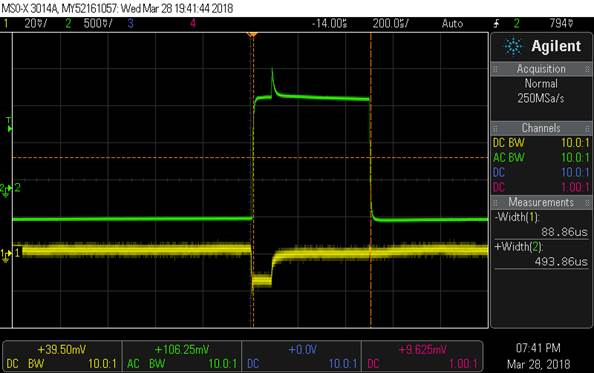Other Parts Discussed in Thread: AFE4490, OPA320, OPA376
I have run into a difficult to explain situation with the OPA381 in a simple TIA configuration with a photodiode in zero-bias photoconductive mode. The system is using a Thorlabs IS236A integrating sphere with an SM05PD1B photodiode. A 660nm red LED is being pulsed at 500Hz (500usec PW) at the input of the integrating sphere using the TI AFE4490 EVM. When the integrating sphere is completely closed with the LED at one input port and measuring the photodiode output, there are what appear to be ~100usec auto-zero glitches at the TIA input and output. Please see below:
In the following scope shot traces: Yellow = TIA inverting input, Green = TIA output
In this shot, sphere is open to ambient light @ one of the ports while measuring the RED LED – all seems normal . . .
In this shot, all integrating sphere ports are closed while measuring the red LED. Yellow trace is TIA input and the voltage should always be zero (i.e. zero-bias action of op-amp summing junction). In this case it looks like an autozero is performed that also glitches the output. Not much detail on autozero in datasheet other than it is proprietary and takes about 100usec. From what I know about chopper stabilized amplifiers, the glitch at the input appears to be an autozero attempt.
This is very repeatable and seems to be related to the dark condition of a totally enclosed integrating sphere.
My questions are:
- Does it seem that this is an artifact of autozero operation?
- Am I required to use reverse bias as in figure 4 of the data sheet when operating from a single ended supply? Would this eliminate the glitch I am seeing here?



